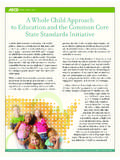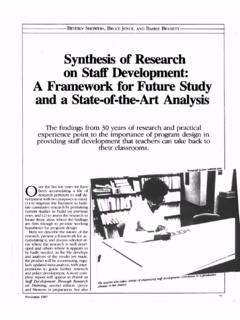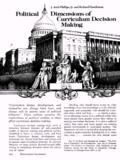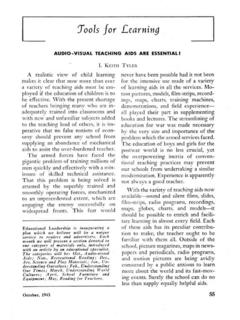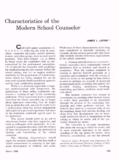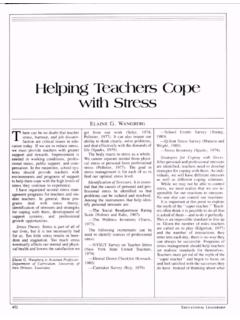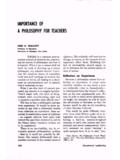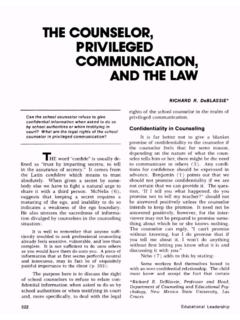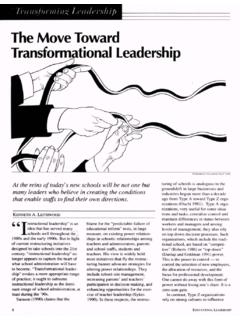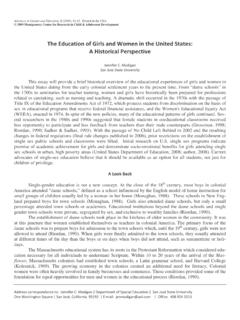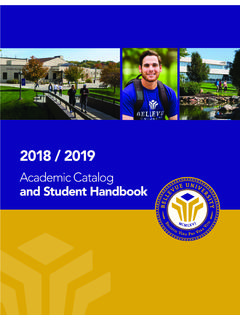Transcription of Pygmalion in the Gymnasium - ASCD
1 Pygmalionin the GymnasiumThe self-fulfilling prophecy is not confined to student academic performance but also applies to the workplace, therapy clinics, and even to since Robert Merton pro posed the concept of the self- fulfilling prophecy in 1948, sociaJ and behavioral scientists have provided support for the accuracy of his insight. Merton noted that when we expect certain behavior of others, we are likely to a = n ways that make the expected behavior more likely to occur. Support for Merton's idea of the interpersonal self-fulfilling prophecy has ranged from the brilliantly anec dotal work of Gordon Allport to the more recent experimental work of numerous investigators.
2 Allport (1950) applied the concept of interpersonal expectancies to an analysis of the causes of war Nations expecting to go to war, he argued, are more likely to do so partly because of those expecta tions. More recent investigators have studied the effects of self-fulfilling prophecies in laboratories as well as in schools, clinics, and workplacesLaboratory Studies of Self-Fulfilling PropheciesThe first experiments employing hu man subjects to produce self-fulfilling prophecies in the laboratory were conducted by Rosenthal and Fode (1963). Ten experimenters each showed a series of photographs of faces to about 20 beginning students of psychology.
3 The experimenters, who were advanced students, asked their subjects to rate each photo on the degree of success or failure theperson in the photo had experienced. The photos had been chosen specifi cally to appear experimental manipulation was simple. Half the experimenters were told that their subjects had been se lected especially as people who would perceive success, and the remaining experimenters were told that their subjects had been especially selected as people who would perceive failure Actually, all subjects were assigned at random to their experimenters De spite the fact that all experimenters read the same instructions to their subjects, those experimenters who ex pected perceptions of success got them.
4 Those who expected less suc cessful perceptions received them Lat er research suggested that the experimenters' tone of voice helped communicate their expectations to the subjectsThe same investigators also studied the effects of experimenters' expecta tions on the maze learning of labora tory rats They found that when experimenters were led to expect bet ter performance from rats that had allegedly been genetically bred for maze-brightness, these experimenters actually obtained better performance from their rats than did experimenters who had been led to expect poor performance from their allegedly maze-dull rats. Some evidence sug gested that the experimenters who expected better performance handled their rats more frequently and more benignly than did the experimenters who expected poorer performance36 EDUCATIONAL LEADERSHIPP ygmalion in the Classroom and ElsewhereIf rats perform better when their experi menters expect them to perform bet ter, then perhaps students will, too To test this hypothesis, Rosenthal and Ja- cobson (1968) randomly selected about 20 percent of the children in 18 classrooms and alleged to their teach ers that these particular children would intellectually bloom in the aca demic year ahead.
5 The only difference between these special children and other students was in the minds of the teachers. Eight months later all the children were tested with a standard IQ test. Results showed that greater intellectual gains had been made by those children of whom more had been expected. Teachers had func tioned as Pygmalions for the specially designated Galateas in their class roomsOther investigators found the Pyg malion phenomenon in other con texts. Albert King (19"7 !) studied Pygmalion as a work supervisor and Galateas as disadvantaged workers learning how to be health workers, pressing-machine operators, assem blers of electronic equipment, weld ers, and automobile mechanics He found that when the supervisors had been led to expect superior work per formance from their workers, that is what they got.
6 In his research, Jeff Herman (1979) found that psychother apists' expectations for their patients' therapeutic outcomes also tended to function as self-fulfilling prophecies. Finally, in a recent meta-analysis, Ro senthal and Rubin (19^8) reported on the results of 345 studies of this phe nomenon and showed that its occur rence was no longer in PygmalionsFor all the research on self-fulfilling prophecies, little was known about the kinds of persons who would be more or less susceptible to biasing informa tion. Then, in 1979. Babad developed a procedure for predicting susceptibility to bias Potential Pygmalions were asked to score, on an "objective" mea surement system, the drawings alleg edly made by two children.
7 One of these children was presented as being of high social status as indicated by name, ethnic group, parental educa tion and occupation, school, area of residence, and so on. The other child was presented as being of low social status. The degree to which the alleg edly high-status child's drawing was scored higher than the allegedly low- status child's drawing (corrected for the small true difference between the drawings) defined the susceptibility to biasing informationIn further research, Babad found high-bias people to be generally more dogmatic or authoritarian than low- bias people. Pushing the research fur ther, Babad and Inbar (1981) found that high-bias physical education teachers-in-training were more auto cratic and more distant in their class room interactions than were the low-bias teachers-in-training.
8 High- bias teachers showed no insight into their behavior; they did not reportthemselves as being any more dogmat ic man their low-bias addition. -Babad. Inbar. and Ro senthal (1982b) found important dif ferences in the evaluation behavior of high- and low-bias teachers. When the essentially unbiased teachers were asked to list those students of whom they expected the most and the least, only one variable predicted group as signment: students' grades in phracal education. When the high-bias teach ers were asked to make the same judgments, their selections were pre dictable not only from their students' physical education grades but from their students' socioeconomic status, quality of clothing, and physical attrac tiveness.
9 Thus, these high-bias teach ers expected better performance from students who not only had performed better in the past, but who were of higher social status and who were more physically and die Golem: Meeting In die GymIn this new study, Babad, Inbar, and Rosenthal (1982a) investigated how high-bias and low-bias teachers be haved toward children for whom they already had high expectations, and how they behaved toward children who were selected at random but who were alleged to their teachers to have special potential for gains in physical performance It was also possible in this study to determine the effects of teachers' expectations on students' ac tual physical performanceSEPTEMBER 1985 lgI KK I k ~ =i =j~ ~ =e j ~ =_~ = > = =q = = = jf= G{{= |=|L= ={= = ={=|q D= HgV=Hgl=HPVHPVe =efY=b = D=?}}}}
10 G={e{ tY_r eG =DHPV=JOKNS=HKSOJPU ijj +J* JKVU=HglH=KMNEfj lowMeme =k ~ =i =j~ ~ =e j ~ HKON+ .02H=KNV=JKPPH=KNQKMMIn the Greek myth, Pygmalion 's love for the statue he sculpted brought Galatea to life; these positive effects were contrasted by Babad with the Hasidic myth of the Golem, in which a mechanical creature is brought to life by its creator. The Golem develops into a monster, runs amok, and must be destroyed. In this study we were able to study both the Pygmalion - Galatea effect and the Golem effect. Teachers treating their low-expectancy students in an especially negative way would clarify the mediation of Pyga- malion-Galatea effects.}}
